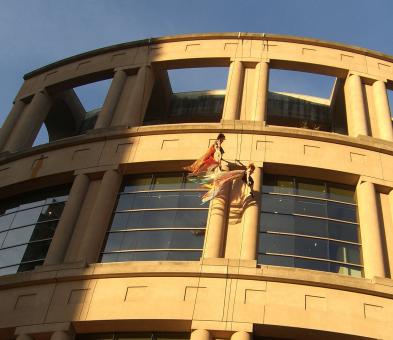Dancing on the Edge – landscape and generous space

The Dancing on the Edge Festival has wrapped for 2008, but our thoughts about it will be appearing on the Plank pages through the rest of this week. There was much to enjoy, a few things to be puzzled at, plenty of laughter and an equal number of muse-worthy pieces.
At the end of a festival devoted to dance, it’s a bit strange to realize that the only dancing I did myself in those ten days was in my living room, the night I got home from watching Edge Five (review on the way!) and clumsily attempted to demonstrate for my partner some of EDAM’s moves.
Whether sitting in darkened rooms or following the red-sequined dress of the masked MC for Dusk Dances, I was reminded of Vancouver dance’s (reputation for) devotion to extreme physicality. In this festival edition, Toronto and Edmonton provided the most theatrical works. For example, the Toronto-conceived Dusk Dances series (including one Vancouver choreographer, Sarah Coffin), Sylvie Bouchard’s Les Moutons involved four actors dressed as sheep, impressively keeping their faces animal-blank as they were sheared, ate hay, pissed in their pen and ran from a wolf. From Edmonton, Brian Webb’s music-theatre piece Nine Points to Navigate prioritized spoken narrative.
Of the Vancouver companies who performed at DOTE, Aeriosa will always take up the most space physically because they’re dancing on a building-sized scale rather than a room-sized scale. The exception to this would be Karen Jamieson’s “Stand Your Ground” piece that took a crowd of viewers from corner to corner in the Downtown Eastside. But all the Vancouver companies presenting works for DOTE this year used space generously, creating performances that stretched limbs and extended jumps to their largest possible arcs of size.
Last November, The Dance Centre hosted a provocative and intelligent panel discussion called Outside In/Inside Out: The Vancouver Dance Aesthetic, including comments from Dena Davida (Tangente, Montreal), Paula Citron (The Globe and Mail) and Brian Webb (Canada Dance Festival) and moderator Stephen White (Dance Victoria). (Their essays can be read online at www.thedancecentre.ca).
In that context, Davida emphasized that the mountains and landscape surrounding Vancouver must have a strong impact on the choreography here. In her article, she writes it this way: So then if anything is to define a distinctive Vancouver dance aesthetic, it will have to be the natural and social environment itself: the environmental framework in which the dancemakers are working.”
Paula Citron’s essay describes the city as “far flung as it is on the other side of the Rockies, wedged between the mountains and the sea. The dominant wellspring of Vancouver dance has been individuality born out of this very isolation, with not much influence, certainly as far as dance is concerned, coming up from our neighbour to the south.”
Even Stephen White, who lives a mere ferry-skip away in Victoria, the city with gorgeous views of the Olympic mountains, enthused about the landscape. In both his spoken and written intros, he describes “the mountains, the lively street scene, that hard-to-describe but exhilarating West Coast vibe.”
Is this meant to account for the physicality of Vancouver dance? And is this really how anyone who grew up in Vancouver – which none of these writers did – experiences the landscape? Why would the landscape influence Vancouver more than it would influence, say, Edmonton, which is arguably even more geographically isolated? One could argue that the work from Montreal – Solid State’s performance of Take it Back – was more about street and space than Alvin Tolentino’s contemplative, plastic-wrapped Man-Woman/Adam-Eve, for example.
I question these assumptions the way I question a pretty postcard for sale in Gastown. Sure, this stunning landscape exists around us; but I’m not so sure the impact of the landscape is all dramatic and gee-ain’t-it-gorgeous the way these writers would have it. To put it another way, even if the mountains and sea are a big influence, what does that actually mean - what is this famous influence and why should we spend time articulating it?
I especially doubt the story of technicolour paradise when I walk around on Robson Street, people-watching the shopper-hectic sidewalks; when I take the Skytrain to Surrey to visit my brother and notice the number of people sleeping, immersed in headphones or doing anything but look outside at the gorgeous mountain views; when I consider that one of Vancouver’s biggest art exports is Jeff Wall, who did plenty of forest and creek-specific works but is best known for his elaborate cinematographic stills; when I walk home to my apartment in the Downtown Eastside and see people longing for roofs rather than the mountain views they can get while they camp out in Crab Park or Oppenheimer Park.
Of course, ideas become simplified and compressed when they're presented in panels, even in conversation. No one expects a single conversation to define, once and for all, what "a" Vancouver aesthetic might be.
But it struck me this morning when I read Andrew Templeton's review of Aeriosa's Cumulus that hey, here's a theatre guy thinking along the same lines - that the easily accessible outdoor beauty around Vancouver shapes our aesthetic. Love to know what you think.



